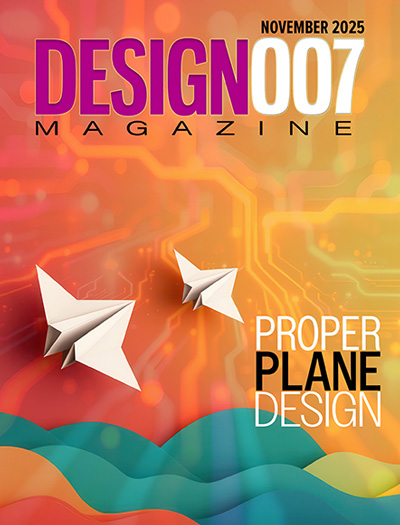-

- News
- Books
Featured Books
- design007 Magazine
Latest Issues
Current Issue
Designing Proper Planes
Without planes, designers would have to create thousands of traces to accomplish the same objectives. Power planes provide low impedance and stable power, and ground planes stabilize reference voltage, improve thermal performance, and help preclude EMI issues.

Power Integrity
Current power demands are increasing, especially with AI, 5G, and EV chips. This month, our experts share “watt’s up” with power integrity, from planning and layout through measurement and manufacturing.

Signal Integrity
If you don’t have signal integrity problems now, you will eventually. This month, our expert contributors share a variety of SI techniques that can help designers avoid ground bounce, crosstalk, parasitic issues, and much more.
- Articles
- Columns
- Links
- Media kit
||| MENU - design007 Magazine
Kelly Dack and Mark Thompson Unite in the War on Failure
September 9, 2015 | Andy Shaughnessy, PCBDesign007Estimated reading time: 2 minutes
There’s been a lot of talk about fighting the war on failure in the PCB industry. But what strategies should our generals follow to prosecute this war? What exactly constitutes a failure in the first place? Is this war even winnable? I recently spoke with longtime designer Kelly Dack and CAM support veteran Mark Thompson of Prototron Circuits about the best battle plans for beating failure, and why designers and manufacturers must team up against this common enemy.
Andy Shaughnessy: Kelly, you recently said, "Failure wins when it leverages the guerrilla warfare tactic of divide and conquer to confuse and disorient the product development community. Designers and manufacturers must unite to fight this war.”
Why don't you start off by saying what failure means to each of you at the design stage and at the board shop stage?
Kelly Dack: Andy, failure is defined as not meeting the intended objective. But I think the concept is easily confused if coming from isolated design and manufacturing perspectives. Meeting the intended objective successfully can only come from allied efforts. Designers need to describe or define objectives for their projects in terms of concise orders in order to make successful products, but this will only come about if the folks giving orders are also able to follow orders.
Mark Thompson: Absolutely, I agree with Kelly entirely. I'd say from the fabrication side, following orders is easy if the orders are given from time-proven, industry standard specification. We open the door for failure when we have to question orders. But we manufacturers have to occasionally, when the orders are outside of the guidelines of conventional process or machine capability. Designer and manufacturer communication and respect is key here, and I think this is why Kelly mentions that it is important that those giving orders must be willing to take them if the order would put the part at risk of failure.
Shaughnessy: Is failure always someone's fault or is it the fault of a bad process, or is it a combination of both?
Dack: I’m not comfortable pointing fingers at individuals. The causes for success and failure can be attributed to people, but it can also be caused by unforeseen conditions or even acts of God. A good strategy is to identify performance requirements and operating conditions. The “battle plan” needs to identify constraints: design constraints, manufacturing constraints, performance constraints, even cost constraints. Knowing the enemy and anticipating every possible way a design could possibly fail is crucial, but it can’t happen in a vacuum. It must occur through open communication with the allies – stakeholders of the product who are connected through the process steps.
Thompson: If you're asking if every failure is someone's fault, I would say yes, at the most base level. It will always turn out to be someone's fault either due to negligence or lack of vigilance. But, as Kelly said, there are extenuating circumstances. There can be dynamic situations where environmental, human or mechanical conditions create a failure in the field. Or it could be a poor design type of situation, where something wasn't properly considered in the original design phase. It’s a good time to draw in the metaphor of a combat unit here. No one person in a combat unit takes credit for the unit’s success or failure. They are a team!
To read this entire article, which appeared in the August 2015 issue of The PCB Design Magazine, click here.
Testimonial
"Your magazines are a great platform for people to exchange knowledge. Thank you for the work that you do."
Simon Khesin - Schmoll MaschinenSuggested Items
Flexible Circuit Technologies Welcomes Senior Applications Engineer Zack Schaner
11/18/2025 | Flexible Circuit TechnologiesFlexible Circuit Technologies a Minnesota-based flexible circuit and advanced electronics contract manufacturer, welcomes Zack Schaner as Senior Applications Engineer.
Cadence Appoints Luc Van den hove to Board of Directors
11/18/2025 | BUSINESS WIRECadence announced the appointment of Dr. Luc Van den hove to its board of directors, effective January 1, 2026.
Accelerating the Global Commercialization of AR Waveguide Technology with AAC Technologies
11/18/2025 | Globe NewswireThe transaction is expected to close within the first half of 2026; upon completion Dispelix will become a subsidiary of AAC.
Beyond the Board: Why More Defense Primes Are Moving Toward Rigid-flex for Lighter, More Reliable Systems
11/18/2025 | Jesse Vaughan -- Column: Beyond the BoardOver the past decade, the conversation around PCB innovation in aerospace and defense has often centered on high-density interconnects, advanced materials, and tighter design-to-fabrication collaboration. But the move toward rigid-flex is a quieter shift that has been gaining momentum, and it’s changing how primes and system integrators approach the physical architecture of mission-critical electronics.
PCB Design Software Market to Hit $12.11 Billion by 2033, Growing at a CAGR of 13.77%
11/14/2025 | Globe NewswireThe PCB Design Software Market Size was valued at USD 4.32 Billion in 2025E and is expected to reach USD 12.11 Billion by 2033 and grow at a CAGR of 13.77% over the forecast period 2026-2033.


